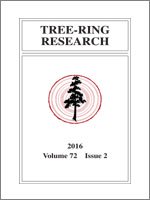The biogeochemistry and ecology of the Arctic environment have been heavily impacted by anthropogenic pollution and climate change. We used ICP-MS to measure concentrations of 26 elements in the AD 1300–2000 tree rings of larch from the Taymyr Peninsula in northern Siberia for studying the interaction between environmental change and wood chemistry. We applied a two-stage data reduction technique to identify trends in the noisy measurement data. Statistical assessment of variance of normalized time series reveals pronounced depletion of xylem Ca, Mg, Cl, Bi and Si concentrations and enrichment of P, K, Mn, Rb, Sr and Ba concentrations after ca. AD 1900. The trends are unprecedented in the 700-year records, but multiple mechanisms may be at work and difficult to attribute with certainty. The declining xylem Ca and Mg may be a response to soil acidification from air pollution, whereas increasing P, K, and Mn concentrations may signal changes in root efficiency and excess water-soluble minerals liberated by the permafrost thaw. The changes seem consistent with mounting stress on Arctic vegetation. This study supports the potential of tree rings for monitoring past and ongoing changes in biogeochemistry of Arctic ecosystems related to pollution and permafrost thaw.
How to translate text using browser tools
1 July 2016
Trends In Elemental Concentrations of Tree Rings From the Siberian Arctic
Irina P. Panyushkina,
Vladimir V. Shishov,
Alexi M. Grachev,
Anastasia A. Knorre,
Alexander V. Kirdyanov,
Steven W. Leavitt,
Eugene A. Vaganov,
Eugene P. Chebykin,
Natalia A. Zhuchenko,
Malcolm K. Hughes
ACCESS THE FULL ARTICLE

Tree-Ring Research
Vol. 72 • No. 2
July 2016
Vol. 72 • No. 2
July 2016
Arctic pollution
Biogeochemical cycling
dendrochemistry
ICP-MS
Larix decidua
Norilsk Nickel smelting complex
permafrost thawing




